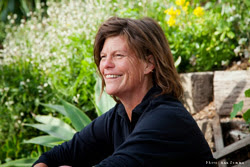What happens when millions of urban Americans decide to grow food? Soil activist Nance Klehm on "dirty activism" - reclaiming a city waste stream to make new gardens. Why is it illegal? Plus: Fukushima update from Alex & stimulating new green music: after Hurricane Sandy and Taiphoon Haiyan, the rich are heading for the hills.
Listen to/download this Radio Ecoshock show 131120 in CD Quality (56 MB) or Lo-Fi (14 MB)
FUKUSHIMA NUCLEAR DISASTER UPDATE: A DANGEROUS MOMENT FOR HUMANITY
Here is the latest from the crippled nuclear reactors at Fukushima Daiiche in Japan.
A robotic survey at Fukushima Reactor Number 1 showed what everyone already knew: highly radioactive water is leaking from the containment vessel to the reactor floor in the basement.
One of the few sources of information is a visiting professor to Hosei University, named Hiroshi Miyano. He says these parts may have been dislodged in the hydrogen explosion at Reactor 1 in March 2011, indicating severe damage occured to the reactor.
Miyano went on to say the same level of damage and radioactive leaks can be expected at Reactors Two and Three, which also exploded. The operator, Tokyo Electric Power Company, did not release an estimate of the amount of radioactive materials leaking from these three reactors.
THE DANGEROUS "MOMENT" AT REACTOR 4
At Reactor 4, the delicate operation to remove uranium and plutonium in fuel rods perched atop the damaged building has begun. Other governments are pressuring Japan to get the fuel out of Reactor 4 before a major earthquake can crash the building or cut off the water cooling supply.
A popular article in Washington's Blog claims attempts to remove Reactor 4 fuel is the most dangerous moment for humanity since the Cuban Missle Crisis in the 1960s. I agree - but this "moment" will drag on for at least a year, possibly several years. After the press has become bored with that project, the ultimate danger of a large nuclear reaction remains.
THE FUEL RODS WILL NOT BE EXPOSED TO AIR
The TEPCO fuel removal plan is only slightly less risky than I feared. Each fuel bundle would be lifted by a remote-operated crane, and hopefully placed within a casket - with the whole operation done underwater. If successful, the casket would be sealed, hauled out by a different crane, and trucked to another ground-level fuel pool on the site. That pond is already over-burdened with nuclear fuel from years of operating the plant.
At Reactor 4, the Japanese have not explained what will happen if one of these fuel bundles contains loose or damaged rods which come in contact with one another.
TEPCO has removed the visible debris that fell into the fuel pool, which included the building roof and a giant industrial crane. What really counts though, is what fell into the nuclear fuel bundles themselves. That remains.
What if rods damaged by debris drop extremely radioactive pellets on the fuel pool floor, or deep within the casings? Were the fuel bundles damaged in the major explosion in Reactor Building 4? What if adjacent fuel rods come into direct contact with one another during the operation?
TEPCO just admitted this week there are up to 80 damaged fuel rods in various Fukushima reactor fuel ponds. Several are in Reactor 4, including fuel bundle badly bent. They've known about that one since 1982 and never did anything about it. It makes you wonder how many other reactors around the world could not unload their fuel in an emergency, due to damaged rods that were never dealt with.
IF GASES DO GET OUT: WHERE WILL THE WIND BLOW?
TEPCO put a Kevlar shroud over the steel beam structure perched over the damaged building. If radioactive gases are released, the company says this will collect the gases and shoot them up a higher chimney, trying to protect the workers below. Up the chimney to where? To the Fukushima area? To winds over Japan? To winds blowing toward Hawaii, Alaska and California? They don't say.
Some experts fear a nuclear reaction is possible. That could mean the whole Fukushima site should be evacuated. But then who would run the daily cooling pumps required to keep all the leaking radioactive water circulating toward the thousand make-shift holding tanks? Preventing an even greater nuclear disaster, both for Japan and the Pacific Ocean, requires many workers on site daily. One false step could take radioactivity beyond the limits of human survival.
Could a nuclear explosion shoot more radioactive particles high into the atmosphere, to fall on North America and the whole Northern Hemisphere? It's certain the Pacific Ocean would get another burst of radiation. If distributed, there is enough nuclear material in the Reactor 4 fuel pool to poison the northern hemisphere.
THE WORST IS YET TO COME
There's plenty more nuclear fuel balanced in the roof of the damaged reactor building 3. That building is seldom discussed because that whole building is too radioactive to be approached, even by robots. Reactor 3 was running a special super plutonium blend called MOX when it exploded. Nuclear fuel remains in Reactors 1 and 2 as well.
Keep in mind, removing nuclear fuel from Reactor 4 may be the EASIEST part of this attempted salvage operation. Radioactivity at Unit 4 is low enough humans can walk around in it. No human has been able to approach Reactors 1 to 3 with in their melt-down state. Even robots are damaged by high radioactivity. Plus there is no plan, and no known technology, to retrieve the melted reactor cores. Nobody is sure where those melted cores are, except they are below and outside the "containment" structures.
The Fukushima nuclear accident is far from over. The worst is yet to come.
NEW SONG: THE RICH ARE GONNA MOVE TO THE HIGH GROUND
Musician Geoff Berner of Vancouver
Regular listeners know the million dollar ocean-front properties of the wealthy are due for a rude wave of storms and rising seas. Vancouver song-writer Geoff Berner is on the case with this observation: in more ways than one, "The Rich Are Gonna Move to the High Ground".
Geoff was recorded outdoors in downtown Vancouver, beside a chain link fence and sign saying "Habitat Closed". Watch it on You tube . Or check out with the lyrics.
Geoff Berner was recorded by Matt Cote for his upcoming film "A Date with Ed". Find it on You tube. Geoff's web site is here.
NANCE KLEHM - RECLAIMING CITY SOIL
Our feature speaker this week is Nance Klehm on bioremediation in the cities. She tells us how to read our surroundings. We also learn about plants that soak up radiation - good to know in Fukushima times.
Nance sees compost as an act of revolution. She's a landscape designer, horticultural consultant and permaculture expert. But mostly, I think Nance is a social activist who isn't afraid to get her hands dirty.
This recording was made by Kelly Pierce of the Chicago Independent Media Center for Radio Ecoshock - at the Bioneers 2013 Chicago Great Lakes conference at the start of November.
Normally you'll find a formal introduction and all that. Instead, Nance found herself in a room with no microphone - after leaving a breakout session on direct action. There, the Reverend Billy of the Church of Stop Shopping fled the room hoping to avoid being arrested. That's where we come in.
Listen to/download this 45 minute talk by Nance Klehm in CD Quality or Lo-Fi
It's hard to face up to our waste products isn't it? To gather up the goo and turn it into soil for city gardens. It's called bioremediation - returning landscapes to natural production using plants. Our guide is Nance Klehm from spontaneousvegetaion.net. Her latest project is called "The Ground Rules." They gather organic waste from business to create compost and soil for the cities.
ONE MORE GREAT SONG
Our closing song was created by Toronto-based singer, rapper, filmmaker and activist Gaiaisi.
There is . It has the best of free footage donated by project collaborators 350 dot org, Climate Reality, Greenpeace, the Rain Forest Action Network and WWF.
But they still need to purchase rights from the BBC series Planet Earth. Gaiaisi needs your help to make sure this video can remain free on You tube, to reach the whole world. Find his change-the-earth-music-video-project on indiegogo.com.
It's one of the best environmental videos of the year for sure. Track it down. Plus here is the Gaiaisi web site with downloads.
NEXT WEEK
Next week we'll hear about one of the few hopeful solutions for climate change. It's the big picture of soil carbon and biochar from Albert Bates, long-time guru at The Farm in Tennessee. Don't miss that.
Please help Radio Ecoshock keep going. You can make a one-time donation, or become one of the needed 150 monthly donors who keep this show on the air. Get the details here.
I'm Alex Smith. Thank you for listening, and caring about your world.




3 comments:
Thanks for another couple of great shows. I used the listening time to chop the ingredients for a giant kettle of borscht, made largely with home-grown vegs. I loved the talk by Nancy Klehm. It also lead me to the bioneers website, and lots more inspiring material. You do great work.
Awesome - just found you - kia kaha from someone in new zealand
Hi SeaJay
For some reason, the number of New Zealand podcast listeners has started climbing the past few weeks.
Maybe it's folks like you putting out the word about Radio Ecoshock.
Welcome aboard.
Alex